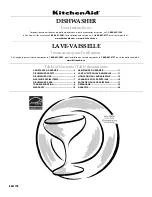
• Corrugated cardboard made from up
to 100% recycled material.
• Expanded polystyrene (EPS) with no
added chlorine or fluorine.
• Supports made from untreated wood.
• Protective plastic made from
polyethylene (PE).
Disposal
• When the dishwasher has reached the
end of its service life and is to be
disposed of, it should immediately be
made unusable. Pull out the power
cable and cut it as short as possible.
• The dishwasher is manufactured and
labelled for recycling.
• Contact your local authority for
information about where and how your
dishwasher should be correctly
recycled.
Before washing for the first time
The water softener
In order to achieve good dishwashing
results, the dishwasher needs soft water
(water with low mineral content). Hard
water leaves a white coating on dishes
and the dishwasher.
Water hardness is specified using the
following scales: The German water
hardness scale (°dH) and the French
water hardness scale (°fH). A water supply
with a water hardness in excess of 6°dH
(9°fH) must be softened. This is done
automatically with the aid of the built-in
water softener. In order for the softener
to function optimally, it must be adjusted
to the hardness of the water supply.
Contact the local waterworks to check the
water hardness in your area.
Adjusting the water softener
Chapter Settings on page 14 describes
how to adjust the water softener.
Fill up the salt
Before you begin using a dishwasher with
a water softener, you must fill the salt
compartment with salt for the water supply
to be softened automatically. Use large
grain salt or special dishwasher salt.
WARNING!
In order to avoid rust stains a
dishwashing programme must be started
immediately after adding salt.
Never pour dishwasher detergent into
the salt compartment. This destroys the
water softener!
Do as follows the first time:
1 Unscrew the lid as illustrated.
4
Содержание Ora-Ito GV60ORAB
Страница 1: ...EN OPERATING INSTRUCTIONS DISHWASHER...
Страница 30: ...Your notes 30...
Страница 31: ...Your notes 31...





































